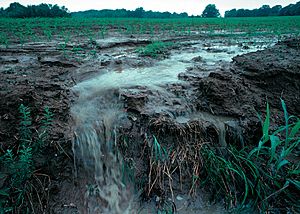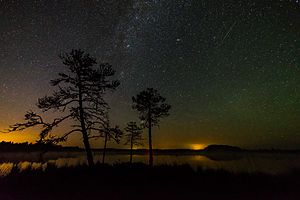Pollutant facts for kids

Pollutants are substances that are harmful to our environment. They can also be bad for people's health over time. Pollutants come from natural sources like minerals and fossil fuels. They are also made by humans.
Many pollutants can be like poison to our bodies. For example, carbon monoxide is a dangerous gas. If you breathe it in, your body takes it instead of oxygen. This can make you feel like you are suffocating and can even lead to death in serious cases.
Some pollutants become dangerous when they mix with other things in nature. For instance, when we burn fossil fuels, gases like nitrogen oxides and sulfur oxides are released. These gases come from impurities in the fuel. When they mix with water vapor in the air, they can create acid rain. Acid rain harms buildings and makes lakes unhealthy for fish and water plants, causing them to die.
Contents
What Are Pollutants?
Pollutants are substances that cause harm to living things and the environment. They can be gases, liquids, or solids. Some pollutants are natural, like volcanic ash. However, most pollutants we talk about are made by human activities. These activities include burning fuels, farming, and making products in factories.
Where Do Pollutants Come From?
Pollutants can come from many places. Some are found naturally in the Earth, like certain minerals. Others are created when we use fossil fuels such as coal, oil, and natural gas. When these fuels are burned for energy, they release harmful gases into the air. Factories and cars are big sources of these types of pollutants.
Humans also create many pollutants. For example, plastics are made by people and can become pollutants if not properly recycled. Chemicals used in farming, like fertilizers and pesticides, can also become pollutants if they wash into rivers and lakes.
How Pollutants Affect Us and the Planet
Pollutants can have many negative effects. They can make the air dirty, which is bad for our lungs. They can also make water unsafe to drink or swim in. When pollutants get into the soil, they can harm plants and the food we eat.
Harm to Living Things
Many pollutants are toxic, meaning they can poison living things. For example, carbon monoxide stops our bodies from getting enough oxygen. This gas is often found in car exhaust and smoke from fires. It's why you should never run a car in a closed garage.
Pollutants can also hurt animals. If fish live in polluted water, they can get sick or die. Birds might eat insects that have absorbed pollutants, which then harms the birds. This shows how pollutants can move through the food chain.
Damage to the Environment
Pollutants don't just affect living things; they also damage the environment itself. Acid rain, for instance, is a big problem. It forms when sulfur and nitrogen gases mix with water in the clouds. This rain then falls and can damage forests, buildings, and statues. It also makes lakes and rivers too acidic for many plants and animals to survive.
Another example is light pollution. This happens when too much artificial light at night brightens the sky. It can make it hard to see stars. It also confuses animals that rely on natural light cycles, like birds migrating or insects navigating.
Other pages
Images for kids
-
The night sky viewed from Luhasoo bog, Estonia with light pollution in the background.
See also
 In Spanish: Contaminante para niños
In Spanish: Contaminante para niños



